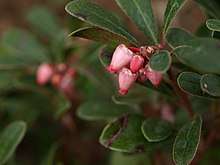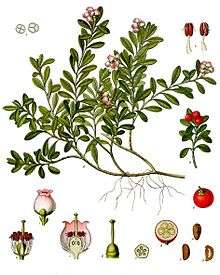Arctostaphylos uva-ursi
| Arctostaphylos uva-ursi | |
|---|---|
| Scientific classification | |
| Kingdom: | Plantae |
| (unranked): | Angiosperms |
| (unranked): | Eudicots |
| (unranked): | Asterids |
| Order: | Ericales |
| Family: | Ericaceae |
| Genus: | Arctostaphylos |
| Species: | A. uva-ursi |
| Binomial name | |
| Arctostaphylos uva-ursi | |



Arctostaphylos uva-ursi is a plant species of the genus Arctostaphylos (manzanita). Its common names include kinnikinnick and pinemat manzanita, and it is one of several related species referred to as bearberry.[2]
Its specific name uva-ursi means "grape of the bear" in Latin (ūva ursī), just like what the generic epithet Arctostaphylos means in Greek ("bear-grape").[3]
Distribution
The distribution of Arctostaphylos uva-ursi is circumpolar, and it is widespread in northern latitudes, but confined to high altitudes further south:
- in Europe, from Iceland and North Cape, Norway south to southern Spain (Sierra Nevada); central Italy (Apennines) and northern Greece (Pindus mountains);
- in Asia from arctic Siberia south to Turkey, the Caucasus, the Levant and the Himalaya;
- in North America from arctic Alaska, Canada and Greenland, south to California, north coast, central High Sierra Nevada (above Convict Lake, Mono County, California), Central Coast, California, San Francisco Bay Area, to New Mexico in the Rocky Mountains; and the Appalachian Mountains in the northeast United States.
In some areas, the plant is endangered or has been extirpated from its native range. In other areas, such as the Cascade Range, it is abundant.
Description
Arctostaphylos uva-ursi is a small procumbent woody groundcover shrub 5–30 cm (2–12 in) high. The leaves are evergreen, remaining green for 1–3 years before falling. The fruit is a red berry.
The leaves are shiny, small, and feel thick and stiff. They are alternately arranged on the stems. Undersides of leaves are lighter green than on the tops. New stems can be red if the plant is in full sun, but are green in shadier areas. Older stems are brown. In spring, they have white or pink flowers.
Pure stands of Arctostaphylos uva-ursi can be extremely dense, with heights rarely taller than 6 inches. Erect branching twigs emerge from long flexible prostrate stems, which are produced by single roots. The trailing stems will layer, sending out small roots periodically. The finely textured velvety branches are initially white to pale green, becoming smooth and red-brown with maturity. The small solitary three-scaled buds are dark brown.
The simple leaves of this broadleaf evergreen are alternately arranged on branches. Each leaf is held by a twisted leaf stalk, vertically. The leathery dark green leaves are an inch long and have rounded tips tapering back to the base. In fall, the leaves begin changing from a dark green to a reddish-green to purple.
Terminal clusters of small urn-shaped flowers bloom from May to June. The perfect flowers are white to pink, and bear round, fleshy or mealy, bright red to pink fruits called drupes. This smooth, glossy skinned fruit will range from 1⁄4 to 1⁄2 inch (6 to 13 mm) in diameter. The fruit will persist on the plant into early winter. Each drupe contains 1 to 5 hard seeds, which need to be scarified and stratified prior to germination to reduce the seed coat and break embryo dormancy. There is an average of 40,900 cleaned seeds per pound.[4]
Subspecies
There are at least five reported subspecies:
- Arctostaphylos uva-ursi subsp. uva-ursi. Common bearberry; circumpolar arctic and subarctic, and in mountains further south.
- Arctostaphylos uva-ursi subsp. adenotricha. Central high Sierra Nevada.
- Arctostaphylos uva-ursi subsp. coactilis. North coastal California, central coast California, San Francisco Bay Area.
- Arctostaphylos uva-ursi subsp. cratericola (J. D. Smith) P. V. Wells. Guatemala bearberry, endemic to Guatemala at very high altitudes (3000–4000 m).
- Arctostaphylos uva-ursi subsp. longifoliosa. Various reports from Canada, U.S.A.[5] May be the same as adenotricha or coactilis.
Sources do not agree on the list of subspecies, so some of these may be identical, or may be separate species rather than subspecies. See bearberry and manzanita. For a list of reported North American subspecies and varietals, see USDA Plants Profile in "External links" below. For a complete list of related plants see Arctostaphylos.
- (Further research needed to clarify botanical classification.)
Chemistry and traditional medicine
Arctostaphylos uva-ursi leaves contain the glycoside arbutin which metabolizes to form hydroquinone, a potential liver toxin.[6] Although bearberry extracts have been used in traditional medicine in belief the treatment alleviates urinary tract infections,[6] there is no high-quality evidence from clinical research that such treatment is effective or safe as of 2018.
Uses
Historically, it was used by the Blackfeet Nation as food.[7]
Smoking
Bearberry is the main component in many traditional North American Native smoking mixes,[8] known collectively as "kinnikinnick" (Algonquin for a mixture). Bearberry is used especially among western First Nations, often including other herbs and sometimes tobacco.
Cultivation
There are several cultivars that are propagated for use as ornamental plants. It is an attractive evergreen plant in gardens, and is useful for controlling erosion. It is tolerant of sun and dry soils and is thus common groundcover in urban areas.
References
- ↑ "Arctostaphylos uva-ursi". NatureServe Explorer. NatureServe. Retrieved 2018-07-18.
- ↑ Casebeer, M. (2004). Discover California Shrubs. Sonora, California: Hooker Press. ISBN 0-9665463-1-8.
- ↑ Wells, Philip V. (2000). The Manzanitas of California. Lawrence, KS: University of Kansas. p. 13. ISBN 978-0-933994-22-5.
The name Arctostaphylos is from Greek: arctos = bear, staphylos = bunch of grapes or berries; hence bearberry, pertaining redundantly to A. uva-ursi (Latin: uva = berry, ursi = of the bear).
- ↑ "Plant Fact Sheet: Bearberry (Arctostaphylos uva-ursi)" (PDF). USDA NRCS Northeast Plant Materials Program. 31 January 2002.
- ↑ Elven, Reidar (ed.). Pan-arctic Flora.
- 1 2 De Arriba, S. G; Naser, B; Nolte, K. U (2013). "Risk assessment of free hydroquinone derived from Arctostaphylos Uva-ursi folium herbal preparations". International Journal of Toxicology. 32 (6): 442–53. doi:10.1177/1091581813507721. PMID 24296864.
- ↑ Hellson, John C. (1974). Ethnobotany of the Blackfoot Indians. Ottawa: National Museums of Canada. p. 101.
- ↑ Moerman, Daniel E. "Arctostaphylos uva-ursi". Native American ethnobotany. pp. 87–88. ISBN 0-88192-453-9.
External links
| Wikimedia Commons has media related to Arctostaphylos uva-ursi. |
